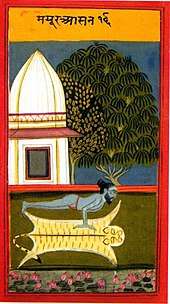Pasasana
Etymology and origins
The name comes from the Sanskrit word पाश, pāśa meaning "noose" or "snare",[1] and आसन, asana meaning "posture" or "seat".[2]
The pose is described and illustrated in the 19th century Sritattvanidhi; a slightly different pose is described in the 1966 Light on Yoga.[3]
Description
In this yoga asana, the human body creates a 'noose' when the practitioner wraps their arms around their squatting legs with their hands clasped behind their back, while twisting to one side.
gollark: If I don't add a pronoun search engine to osmarks.tk to search someone's entire internet history for any mention of their pronouns, am I not being accepting?
gollark: If someone insists on certain pronouns and they're either weird/nonstandard (and I don't like them), or they change them all the time, I will ignore them and say "they" or something.
gollark: Yes. I just go by "them" or probably something else if someone asks and I remember.
gollark: https://pronouny.xyz/pronouns/5e3fea8210cd490015d1631d
gollark: so how do I set pronouns?
See also
References
- "Pashasana". Ashtanga Yoga. Archived from the original on 28 August 2012. Retrieved 27 January 2019.
- Sinha, S. C. (1996). Dictionary of Philosophy. Anmol Publications. p. 18. ISBN 978-81-7041-293-9.
- Sjoman, Norman E. (1999) [1996]. The Yoga Tradition of the Mysore Palace. Abhinav Publications. pp. 76, plate 8 (pose 47). ISBN 81-7017-389-2.
Further reading
- Iyengar, B. K. S. (1 October 2005). Illustrated Light On Yoga. HarperCollins. ISBN 978-81-7223-606-9. Retrieved 9 April 2011.
- Saraswati, Swami Satyananda (1 August 2003). Asana Pranayama Mudra Bandha. Nesma Books India. ISBN 978-81-86336-14-4. Retrieved 9 April 2011.
- Saraswati, Swami Satyananda (January 2004). A Systematic Course in the Ancient Tantric Techniques of Yoga and Kriya. Nesma Books India. ISBN 978-81-85787-08-4. Retrieved 9 April 2011.
External links
This article is issued from Wikipedia. The text is licensed under Creative Commons - Attribution - Sharealike. Additional terms may apply for the media files.

_from_Jogapradipika_1830_(detail).jpg)

